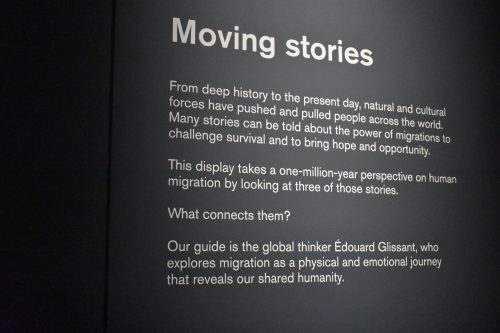
On Tuesday, we visited the British Museum with Arnab to see two special event exhibits: Moving Stories and Iranian Voices: Recent Acquisitions of Works on Paper. Both exhibits were similar in that they both revealed something beyond media’s portrayal of current issues such as immigration, Islam, and Muslims. Moving Stories revolved around the topic of immigration and Iranian Voices: Recent Acquisitions of Works on Paper provided multiple historical and cultural information about Iran and other countries with Muslim influences.
Although both exhibits interested me, Moving Stories was particularly compelling.
Let’s take a step back.
Imagine entering a massive building designed in classic Greek architecture: large columns and probably human sculptures plastered at the top of the triangular platform above the columns. See the picture I took if you need help visualizing.
As you enter this overpowering building it’s even more overwhelming inside, it’s so huge it’s easy to get lost. But fear not! Our special event exhibit is immediately to our right.

Don’t be discouraged by the size of the exhibit. Yes, compared to the grandiose entrance of the museum our special event exhibit is meek. But! The content is rich… or is it? Oh, don’t worry about that random wooden cubic tunnel in the middle, I’m sure we’ll get to it.
It’s fitting that our special event exhibit Moving Stories is part of the Asahi Shimbun Displays, because it’s centered around movement and change. Check out the photo of the description of the Asahi Shimbun Displays that accompanied our exhibit.
Let’s begin our exhibit exploration!
- Irony of borders: They protect people from outside forces, but also prevent people from leaving
- Permeability of borders: “Must be permeable; not weapons against migration or immigration processes” (Glissant)
- Borders as a necessity: “Necessary in order to appreciate the passage, to feel the different flavors and atmosphere while passing through the border” (Glissant)

The subject of borders has been on my mind since our current president’s election to office. When I visited the San Diego border with my Visions of California OCS program I experienced the irony of borders that Édouard Glissant touched on. The border passes through Friendship Park where religious and social gatherings take place between families and community members from both sides. When I was next to the border I felt imprisoned by the large, impermeable metal gate despite being on the side of my residence.
As an immigrant from the Philippines myself, I couldn’t help but agree with Glissant’s thoughts on the permeability of borders.
The following piece, A Journey Caught in Time provides a historical evidence of the importance of migration. It is literally a 3D copy of a footprint that was part of the footprints discovered in Happisburgh in Norfolk in 2013. This piece is also accompanied by the wooden cube tunnel art piece, The Happisburgh Footprints, smack in the middle of the room. Inside the tunnel, we see a projection of the footprints on the floor and hear sounds of the sea and distant voices (See fun images). These footprints show the permeability of borders in the past when the concept of borders were that of natural boundaries.

We are all immigrants! WHAT? Okay, I’m insane in the membrane… Moving on!
I disagree with Glissant’s belief that borders are necessary in order to appreciate the differences between cultures. Borders are not established so that one can feel like they are entering a different world, they are established so that rulers can say, “Mine” and then have something to fight over. Cities don’t have enforced borders, but we can detect culture change through things like slang, clothing, and even age. The establishing of borders results in the separation of people, as the last exhibit piece shows.
Our last piece, Ali’s boat diary 1, 2014 by artist Sadik Kwaish Alfraji, is a story composed of seven rows of images. The story reads from right to left and each row is accompanied by verses. Ali’s boat diary powerfully captures the emotional pain and challenges many immigrants experience.
Boats and snakes were recurring themes in the diary images as well as the verses that accompanied them. The verses in row one alludes to what the repeated images of boat and snakes might represent:

“Don’t put all your dreams in one boat,
Ali
Beware of snakes, Ali, beware of
Snakes, Ali
Stay as far away from your boat as
you can, Ali… This boat will lead to
delusion after delusion after darkness.
It does not give you the redemption
that you seek…”
The boat represents a plan of action and, as such, the artist warns his nephew Ali not to rely on just one plan. This is similar to the phrase, “Don’t put all your eggs in one basket.” As if the artist is speaking from personal experience, he warns Ali not to obsess over his plan of action as it can only lead to “delusion after delusion after darkness.” His warning of the never-ending false hope that will come if he dwells on this plan of action resonates with the narratives of many immigrants. Oh the American Dream.
Sandwiched between the images of boats is his caution of snakes, a symbol of evil. In the Bible, it was a serpent that derailed Adam and Eve from the path of good. The artist in this case is telling his nephew that there are challenges and they can be people too. I think this bit is relatable whether or not a person identifies as an immigrant, right?
Don’t believe everything you read. Come see for yourself. Moving Stories is up in Room 3 of the British Museum until April 30th of this year. The best part? It’s freeeeeeeeeeeee!
~Edylwise Romero, ’19
